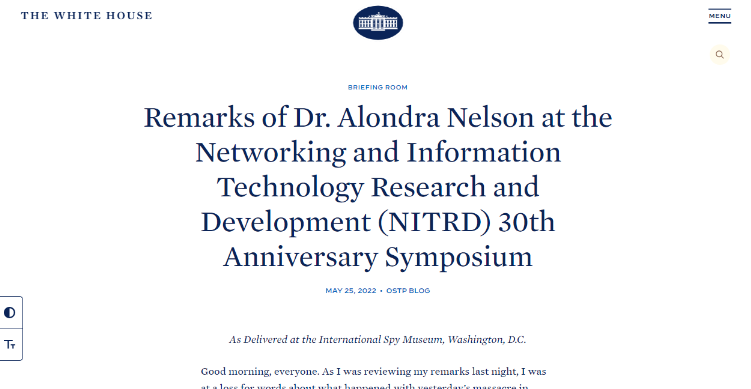(This article appeared as an OSTP BLOG post on May 25, 2022.)
As Delivered at the International Spy Museum, Washington, D.C.
Good morning, everyone. As I was reviewing my remarks last night, I was at a loss for words about what happened with yesterday’s massacre in Texas.
For most of my career, like many of you, I have been first and foremost a teacher. And a classroom is, for many reasons, a sacred space.
I grew up in classrooms where, what occurred yesterday, we couldn’t even have imagined ever happening in a classroom we attended.
It is devastating. And devastating most of all to the parents and loved ones of the 19 schoolchildren and two teachers who were tragically lost yesterday.
So, to begin this morning, I just wanted to be honest about the fact that I’m struggling to really articulate what needs to be articulated — which is that what happened yesterday was not inevitable, and it is indeed unacceptable.
I know that we have to — as a nation, as colleagues — keep fighting for a safer and more just society. And as President Biden said last night, it’s time to turn our pain into action. And he added that we must act, we have to act.
But right now, today, this morning — as you know, as Kamie shared as well, I think — is hard for all of us. And I just wanted to begin this day by acknowledging that.
As Kamie noted, I have the privilege of leading the White House Office of Science and Technology Policy, or OSTP — where we work to maximize the benefits of science and technology to advance health, prosperity, security, environmental quality, and justice for all Americans.
And today, we are here to celebrate the 30th anniversary of the Networking and Information Technology Research and Development program — otherwise known as NITRD.
So I want to thank Kamie for her introduction, for her leadership, and for having me here today with all of you.
To Kamie, and everyone at NITRD: congratulations on reaching this milestone.
We at OSTP are tasked by Congress and President Biden to harness the power and possibilities of science and technology, not just for today, or for tomorrow, but for decades to come — to meet the challenges of the present, while reimagining what our nation can and should look like in the future.
And 30 years ago — shortly before Congress passed the High-Performance Computing Act, which launched what we now know as the NITRD program — OSTP looked to the future, and published a report on “Grand Challenges [in] High Performance Computing and Communications.”
Among other things, the report said:“High performance computing and computer communications networks are becoming increasingly important to scientific advancement, economic competition, and national security. The technology is reaching the point of having a transforming effect on our society, industries, and educational institutions.”
Looking back on those words of 30 years ago, I think our predecessors could only have dreamed of how transformative these technologies would actually become — from empowering us to join a work meeting or attend school while sitting at our kitchen tables, to computers that can learn to translate languages and identify the likelihood of cancers in patients.
One person who imagined this future, perhaps better than some of us, was the High-Performance Computing Act’s author and champion: then-Senator and later Vice President Al Gore.
A few months before Congress passed what almost everyone referred to as “the Gore bill,” he wrote that “such machines will reshape human civilization even more quickly and more thoroughly than did the printing press.”
He envisioned a future of digital libraries. A future of international research collaborations, where scientists around the world could work together on projects in real-time. A future in which “a scientist or an engineer designing a product could immediately transfer a design to the manufacturer, who in turn could transfer it instantly to computer-operated machines ready to turn the idea into reality.”
That’s the future that NITRD was intended to help create — full of things that are now so real, we can hardly imagine a future without them.
When we reflect on what technology was capable of 30 years ago, the changes we’ve experienced are indeed astounding.
Over the last 30 years, supercomputing processing power grew from gigaflops to teraflops to petaflops — such that today’s top supercomputers are over 1 million times more powerful than those of the early 1990s. And we routinely link together hundreds of thousands of computers in data centers to work on tasks, for cloud computing and other uses.
Over the last 30 years, network transmission speeds accelerated, from kilobits per second to megabits to gigabits and even now terabits per second — high speeds that typically haven’t been accessible for all of America, but soon will be, as President Biden and Vice President Harris are ensuring that every home in America can access affordable high-speed internet.
Over the last 30 years, global Internet usage exploded, from roughly 100 gigabytes per day, to some 150 million gigabytes per second. Meanwhile, the number of people online has grown from just a few million in mostly wealthy countries, to more than 5 billion people in all countries around the world.
And along the way, innovation at this scale has brought even more attention to efficiency and equity — recognizing the climate impacts of technology use, and the need for technology to include and benefit everyone.
Throughout those 30 years, what began as the High-Performance Computing and Communications program, now NITRD, played a critical role:
- enabling, for instance, research at the National Center for Supercomputing Applications, where one of the first widely-used web browsers was born;
- supporting a National Research and Education Network, and later a National Information Infrastructure — what then-Vice President Gore called the “information superhighway,”
- and coordinating federal research and development funding in computing, networking, and information technologies that were foundational to the connected world we have today.
Part of what has made this all possible, is that NITRD doesn’t just coordinate research and development on networks. It is a network itself.
At its core, NITRD is about people working together — across more than two dozen member agencies, and another 60 participating agencies — to make strides in technology innovation and discovery.
Because it takes all of us — all of our different skills, diverse experiences, and areas of expertise — to create transformational technologies. And it’s this collaborative nature that makes the NITRD network work.
As the first of several national coordination offices that are overseen by OSTP and the National Science and Technology Council, NITRD has been a model that we’ve used to advance progress in other areas: from research on global warming and climate change, to nanotechnology, and more recently, to quantum information sciences and technology.
As members of NITRD work to research and develop technology that changes our world, we, too, must change — to ensure that we’re approaching this work in ways that benefit all individuals and all communities across America.
This means advancing equity in technology, and technology for equity. Because we recognize there is a powerful intersection between technology and society — where diversity can drive discovery, and where technology can level the playing field for underserved and underrepresented communities.
I’m glad to say that as NITRD enters its fourth decade, it continues to evolve and adapt to keep America on the cutting edge — from coordinating efforts to establish artificial intelligence research institutes across the country; to standing up a new interagency working group to research the challenges posed by misinformation, disinformation, malinformation, and propaganda online; to last year, creating a “STEM 4 ALL” portal to help bring more people into federal science, technology, engineering, and math careers, so that students, educators, and early career researchers can find jobs, internships, scholarships, and other training opportunities in government.
Given all of this transformative change over the last 30 years, we can only imagine what will happen over NITRD’s next 30 years. And today, we’ll explore what that future holds — in the areas of computing at scale, networking and security, artificial intelligence and machine learning, privacy and the internet of things, and how technology can benefit society.
On all of these issues and more, I look forward to seeing where NITRD will take all of us. And congratulations again on this remarkable anniversary.
It is now my honor to introduce my friend and colleague, the director of the National Science Foundation, Dr. Sethuraman Panchanathan. As a computer scientist and engineer, Dr. Panch’s scientific contributions have brought advancements in human-centered computing, and a multitude of technologies that help people every day. And while he isn’t able to be with us in person today, he has sent a short video message for us, and so with that, I will pass the mic to Dr. Panch.
###


